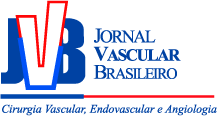Tratamento endovascular de pseudo-aneurisma da artéria subclávia em criança hemofílica
Endovascular treatment of subclavian artery pseudoaneurysm in a hemophiliac child
Emanuella Galvão de Sales e Silva; Ricardo Wagner da Costa Moreira; Elias Arcenio Neto; Camila de Campos Silva; Charles Edouard Zurstrassen; Flávio Roberto Cavalleiro de Macedo Ribeiro; Orlando da Costa Barros; Marcelo Calil Burihan; Felipe Nasser; José Carlos Ingrund; Adnan Neser
Resumo
Palavras-chave
Abstract
Keywords
References
Brettler DB, Levine PH. Clinical manifestations and therapy of inherited coagulation factors deficiencies. Hemostasis and thrombosis: basic principles and clinical practice. 1994:169-83.
Rodgers GM, Greenberg CS. Inherited coagulation disorders. Wintrobe's Clinical Hematology. 1999:1682-732.
Domm JA, Hudson MG, Janco RL. Complications of central venous access devices in paediatric haemophilia patients. Haemophilia. 2003;9:50-6.
Morado M, Jimenez-Yuste V, Villar A. Complications of central venous catheters in patients with haemophilia and inhibitors. Haemophilia. 2001;7:551-6.
Tarantino MD, Lail A, Donfield SM. Surveillance of infectious complications associated with central venous access devices in children with haemophilia. Haemophilia. 2003;9:588-92.
Casado-Flores J, Barja J, Martino R, Serrano A, Valdivielso A. Complications of central venous catheterization in critically in children. Pediatr Crit Care Med.. 2001;2:57-62.
Ruesch S, Walder B, Tramer MR. Complications of central venous catheters: internal jugular versus subclavian access: a systematic review. Crit Care Med.. 2002;30:454-60.
Lassance P, Neto AS, Néri EM. Cateterizações em pediatria. Tubos, sondas e drenos. 2000:57-65.
Ewestein BM, Valentino LA, Journeycake JM. Consensus recommendations for use of central venous access devices haemophilia. Haemophilia. 2004;10:629-48.
Peces R, Navascues RA, Baltar J, Laures AS, Alvarez-Grande J. Pseudoaneurysm of the thyrocervical complicating percutaneous internal jugular-vein catheterization for hemodialysis. Nephrol Dial Transplant.. 1998;13:1009-11.
Akgun S, Civelek A, Baltacioglu F, Ekici G. Successful endovascular repair of a subclavian artery pseudoaneurysm. Nephrol Dial Transplant.. 1999;14:2219-21.
Criado E, Martson WA, Ligush J, Mauro MA, Keagy BA. Endovascular repair of peripheral aneurysms, pseudoaneurysms, and arteriovenous fistulas. Ann Vasc Surg.. 1997;11:253-63.
Pelchovitz DJ, Cahill AM, Baskin KM, Kaye RD, Towbin RB. Pseudoaneurysm in children: diagnosis and interventional management. Pediatr Radiol.. 2005;35:434-9.
Liddell RP, Patel S, Neuwirth M, Hebert J, Arepally A, Hofmann LV. Transcatheter coil embolization of large pulmonary artery pseudoaneurysm in a child. J Vasc Interv Radiol.. 2003;14:923-7.
Celiker A, Bilgic A, Karagoz T, Pac A. Endovascular stent implantation in congenital heart defects. Turk J Pediatr.. 2001;43:59-64.
Pass RH, Hsu DT, Garabedian CP, Schiller MS, Jayakumar KA, Hellenbrand WE. Endovascular stent implantation in the pulmonary arteries of infants and children without the use of a long vascular sheath. Catheter Cardiovasc Interv.. 2002;55:505-9.
Okubo M, Benson LN. Intravascular and intracardiac stents used in congenital heart disease. Curr Opin Cardiol.. 2001;16:84-91.
Merrot T, Portier F, Galinier P. Trauma of the renal pedicle in children: Report of 2 cases of late revascularization with endovascular prosthesis. Prog Urol.. 2000;10:277-81.
Mayer SA, Brun NC, Begtrup K. Recombinant activated factor VII for acute intracerebral hemorrhage. N Engl J Med.. 2005;352:777-85.
Arkin S, Cooper HA, Hutter JJ. Activated recombinant human coagulation factor VII therapy for intracranial hemorrhage in patients with hemophilia A or B with inhibitors: Results of the NovoSeven emergency-use program. Haemostasis. 1998;28:93-8.
Rice KM, Savidge GF. NovoSeven (recombinant factor VIIa) in centeral nervous systems bleeds. Haemostasis. 1996;26(1):131-4.

